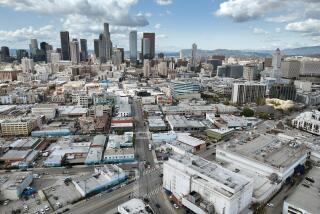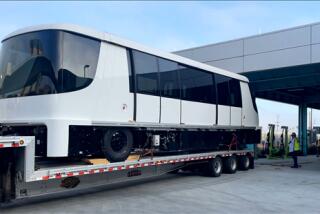In a holding pattern for decades, LAX development gains traction
Like other improvements at Los Angeles International Airport, plans to develop 358 acres on its northern boundary have proceeded at a glacial pace. That is, until now.
Sparked by new pressures from the community, City Hall and the federal government, airport officials have resurrected a dormant proposal for the scrubby strip of property that runs along Westchester Parkway, from Pershing Drive in Playa del Rey to Sepulveda Boulevard in Westchester.
Their plan calls for putting playing fields, parks, educational centers, shopping areas and low-rise office buildings on land that was once a residential neighborhood. The houses there were razed decades ago to create a noise buffer for the airport’s north runways.
But first, officials with Los Angeles World Airports, the operator of LAX, want to hear what nearby residents think because some of them battled earlier modernization plans, complaining that they had not been adequately consulted.
“Community involvement is critical,” said Lisa Trifiletti, the airport’s Northside project manager. “We need to bring all the stakeholders together to take a fresh look at this and develop a unified vision.”
Airport officials held their first community meeting at Orville Wright Middle School in Westchester earlier this month to let residents get a glimpse of the proposal. The latest concept envisions roughly 2 million square feet of development, less than half of what was called for in a plan approved in 1984.
Airport officials say they want to create a variety of land uses that satisfy the needs of the surrounding community and LAX. The western end would be set aside for open space and recreation while land on the east side closer to Sepulveda would be used for shopping, restaurants, hotels, and offices. Planners want to reserve space in the middle parcels for education, research, civic groups and nonprofits.
Already, Otis College of Art and Design, the YMCA, Westchester High School, the American Youth Soccer Organization and the Westchester Youth Foundation have signaled an interest in some of the property, Trifiletti said.
Residents and community activists who have challenged past expansion plans for LAX praised the Northside proposal and the airport’s cooperative approach. They said it contrasts with earlier efforts of mayors Richard Riordan and James Hahn to press ambitious master plans for the airport that would have affected surrounding neighborhoods.
“Working with Lisa Trifiletti is a breath of fresh air. I believe she wants to do the right thing,” said Craig Eggers, co-chairman of the airport relations committee of the Neighborhood Council of Westchester/Playa. “If LAWA and all the entities involved are really acting in good faith and discussing this with the community, it is because they want to make it happen. Wow. Isn’t this nice?”
Eggers said the lack of transparency and concern for the community helped trigger strong opposition to earlier LAX master plans — a fight that delayed airport improvements for years. A 2006 court settlement finally cleared the way for certain projects but shelved others.
“If this comes to fruition, it will create a more interesting community, increase property values and abate some of the noise,” said Harry Stephens, whose family has lived on West 91st Street immediately north of LAX since 1976. “They have been talking about this since I first moved in.”
Using millions of dollars in noise abatement grants from the Federal Aviation Administration, LAX bought the Northside property in the late 1970s and early 1980s and tore down dozens of homes. Foundations and old lampposts can still be seen on the empty land.
Since the purchase, little has been done to the property except for the restoration of three holes at the adjacent Westchester Golf Course and the construction of Los Angeles City Fire Station No. 5 and a child care center for employees of Los Angeles World Airports.
Officials said the Northside redevelopment has been delayed by revisions to the plans made over the years, changes in airport priorities after the Sept. 11 attacks, and the FAA’s unwillingness to approve the project without more details on the layout and type of buildings.
Work accelerated in 2009 when the FAA conducted a national review of how noise grants were being spent by airports and asked LAX officials to submit a reuse plan by 2010. Pressure to do something has come from the community and City Councilman Bill Rosendahl, whose district includes LAX.
Airport officials want to finish the project’s environmental impact analysis by the end of 2012 and seek approvals from the FAA, the airport commission and the City Council in 2013.
More to Read
Sign up for Essential California
The most important California stories and recommendations in your inbox every morning.
You may occasionally receive promotional content from the Los Angeles Times.











